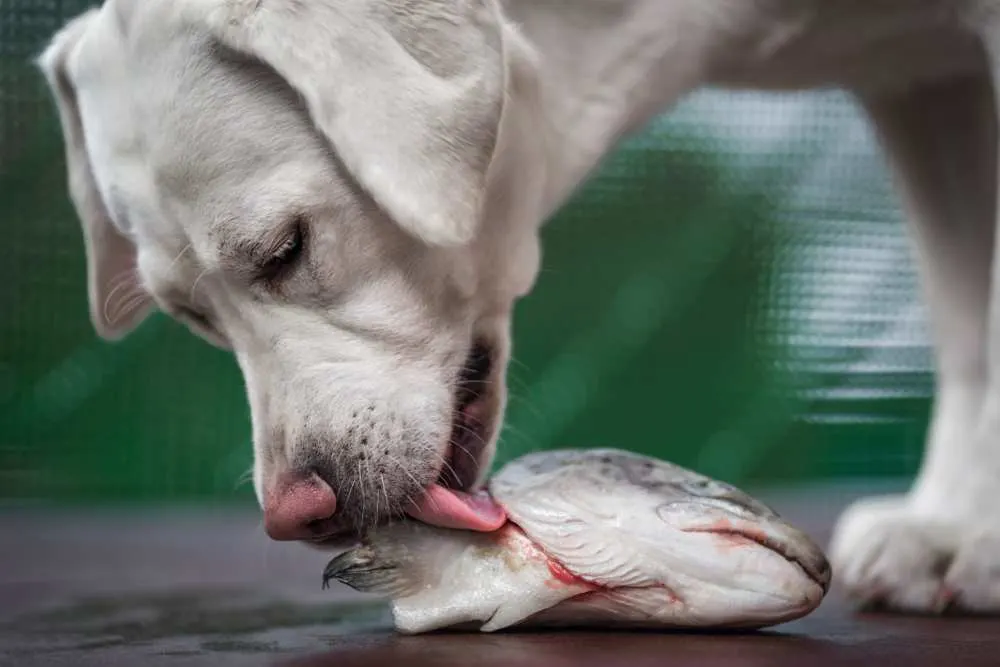Your dog often craves the food you’re preparing for yourself. Whatever you do, you can’t stop him, he’s going to whine until you finally give in.
Today, you were making fish for dinner, and sure enough, your dog was there to beg for just one bite. You would’ve given him some, but you don’t want to put him in danger. You’re not sure can dogs eat fish.
To find out can dogs even eat fish, are there any benefits to dogs eating fish, and more, continue reading!
Can Dogs Eat Fish?
Without any delay, yes, dogs can eat fish. Dogs can even enjoy eating fish and it’s beneficial to their health. Fish can even be a regular part of their diet, too – but make sure to introduce the fish properly for the best results.
Some dog food manufacturers like Purina have regular dog food with fish. That’s one more point toward giving your dog fish! Just make sure to watch your dog after giving it fish for the first time – dogs can get food allergies just like humans!

Introducing Fish To Your Pet’s Diet
When you decide to start giving your dog some new food, it’s principal that you introduce it to their diet. Introducing a food item means giving the pet a small quantity the first time, and giving them more and more each time.
So, the first time you give your pet fish, just add a bite or two to their regular meal. Afterward, watch the dog closely to see if it’s behaving unusually in any way. If it is, discontinue using fish, it doesn’t sit right with your pet!

How To Prepare Fish For Your Dog?
Giving your dog some new food is not easy – there are a lot of things to keep in mind. Dogs cannot digest everything humans can. You should always keep that in mind when you give your dog some dinner leftovers.
So, the first thing we wanted to talk about it is seasoning. Dogs simply cannot eat fish seasoned for humans – herbs and spices can upset your pet’s tummy!
Also, it’s best to feed your dog fish prepared without oil or butter. So, no, you can’t feed your dog leftovers because oils and fats can be tough on the dog’s digestive system. It’s best to prepare fish separately – some for you, and some for your pet.
Raw Vs. Cooked Fish
What is the best way to serve your dog fish? Raw or fully cooked?
What we recommend is always serving the fish fully cooked. Raw fish can carry bacteria like salmonella and listeria – which can make your pet very ill. So, it’s not the greatest idea in the world to give the dog raw fish, and we certainly advise you against that.
Can Dogs Eat Fish Bones?
Fishbones are the biggest risk that accompanies giving your pet fish. Bones are small, fragile and they break easily – which means they can easily get stuck in your pet’s mouth, stomach, or intestines! Also, a fishbone can even perforate the organ wall. Either way, the pet’s health can be in serious trouble when eating fish, so please, be careful.
When you prepare fish for your furry baby, it’s best that you use fillets – they are free of any bones and they are super safe for your pet. Furthermore, you can always feed your pet canned fish – even if it does have a few bones inside. The bones have softened over time in the can and they’re no longer a harm to your pet. Just make sure to pick a can of fish soaked in water or brine – no vegetable oil!

What Type Of Fish Is Safe For Your Pet?
There are so many types of fish your dog can eat, but, what are the best options?
Fish like catfish, ocean and lake whitefish, salmon, flounder, and Arctic char are the best types of fish for your pet. These types of fish are found in dog food, too – so they are perfectly safe for your pet.
On the other hand, fish like tuna and swordfish are long-lived species. That means that these types of fish can accumulate heavy metals like mercury in their system – which can lead to an illness called heavy metal poisoning. Ingesting heavy metals can be very harmful to your pet in the long run, so it’s best avoided completely.
The only exception of the long-lived species is sardine. Sardines can contain mercury, but in a meager quantity compared to tuna and swordfish.
Our top pick is the catfish. Your dog loves it and it’s great for its health, too. Make sure to serve deboned catfish for your pet, though!
Serving Salmon To Your Pet
If you’ve decided to give your pet salmon, there are a few things to keep in mind before you even start. First off, we feel it’s important to note once again that you should never give your dog seasoned food. Herbs and spices are a no-go.
So, when preparing salmon, avoid any spices, especially garlic. Salmon can be boiled, poached, baked, or grilled – just make sure to use no oil when cooking!
Besides, avoid giving the dog smoked salmon. Smoked salmon contains too much salt and it can contain bacteria harmful to your pet!

Benefits Of Your Dog Eating Fish
Actually, fish is not only safe for your pet to eat, but it’s also very healthy! Fish contains many nutrients that your pet needs in order to live a long, happy, and vibrant life!
So, let’s check out the nutritional value of 1 fillet of catfish (5 ounces), cooked:
| Calories | 150 |
| Total Carbohydrates | 0g |
| Total fat | 4.1g |
| Protein | 26.4g |
| Vitamin A | 71.5 IU |
| Thiamin | 0.3mg |
| Niacin | 3.4mg |
| Vitamin B6 | 0.2mg |
| Vitamin B12 | 4.1mcg |
| Calcium | 15.7mg |
| Magnesium | 40mg |
| Zinc | 0.9mg |
As we can tell in the nutrition data table, cooked catfish is packed with valuable compounds your pet needs to thrive. Something we wanted to put an accent on is that your pet doesn’t need fish regularly, it should be eaten in moderation – a few times a week.
However, if you do want to give your pet fish on the regular, adding a modest amount to the meal is the way to go. Although, it’s best to consult your veterinarian on how much fish can your dog eat daily.
Now, let’s check out the benefits of your puppy eating fish:
| Decreases inflammation: | Fish is rich in omega-3 fatty acids, which are proven to reduce inflammation |
| Good for eyesight: | Vitamin A helps maintain great vision |
| Immune system: | Fish has a lot of zinc, iron, selenium, and magnesium – which are essential for your pet’s immunity to diseases |
| Joint health: | Vitamin B6 and B12 are crucial for your dog’s bones |
| Dental health: | Vitamin D promotes healthy teeth and gums |
Different types of fish are rich in different nutrients. A catfish is a great option because it offers a lot of nutrients in a low amount, so it’s all right for your pet to eat on the regular.
Still, let’s see what nutrients are packed in different types of fish (for comparison)
| Herring: | Vitamin D, zinc, vitamin A |
| Cod: | Magnesium, B6, and B12 |
| Whitefish: | Iron and selenium |
| Salmon: | The best source of protein (in fish), rich in vitamin B12 and iron |
| Sardine: | Zinc, selenium, vitamin B12 and phosphorus |

If The Dog Eats Too Much Fish
Every dog can be a little insatiable when it likes a certain food a lot. This time, it was fish – and the dog ate everything in a minute. Are there any dangers associated with too much fish?
First of all, no. If you introduced fish to its diet and the dog isn’t allergic to fish – the worst that can happen is a little vomiting. That happens due to the excessive amount of food ingested but it won’t put your pet in harm’s way.
Make sure that you don’t give the dog too much fish at once and prepare it properly – and your dog will be safe and sound!

Conclusion
We concluded that dogs can eat fish. Fish is a great meal for any pup when consumed in moderation. Nutrients found in fish will keep your pet healthy and wagging its tail for years to come.
Just follow the guidelines above when preparing a meal, and your pet will be safe eating some catfish or sardines!
Learn More: What Can Dogs Eat? A Comprehensive List Of Dog-safe Foods


